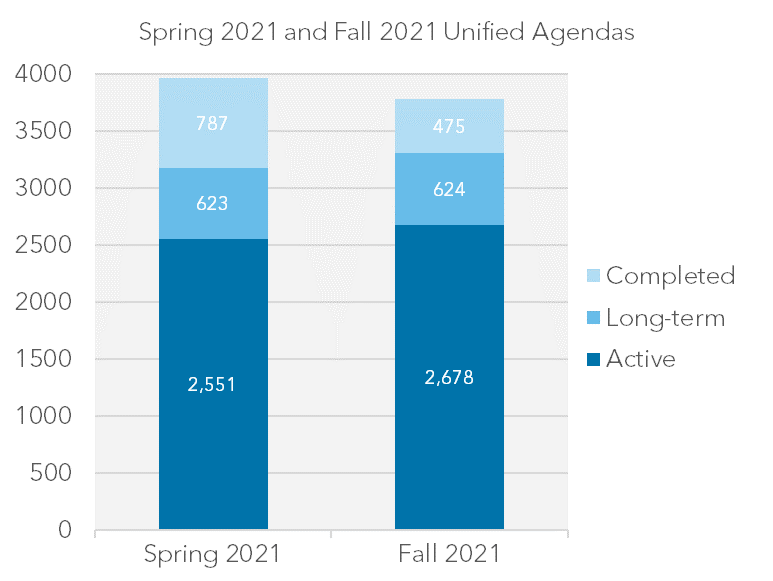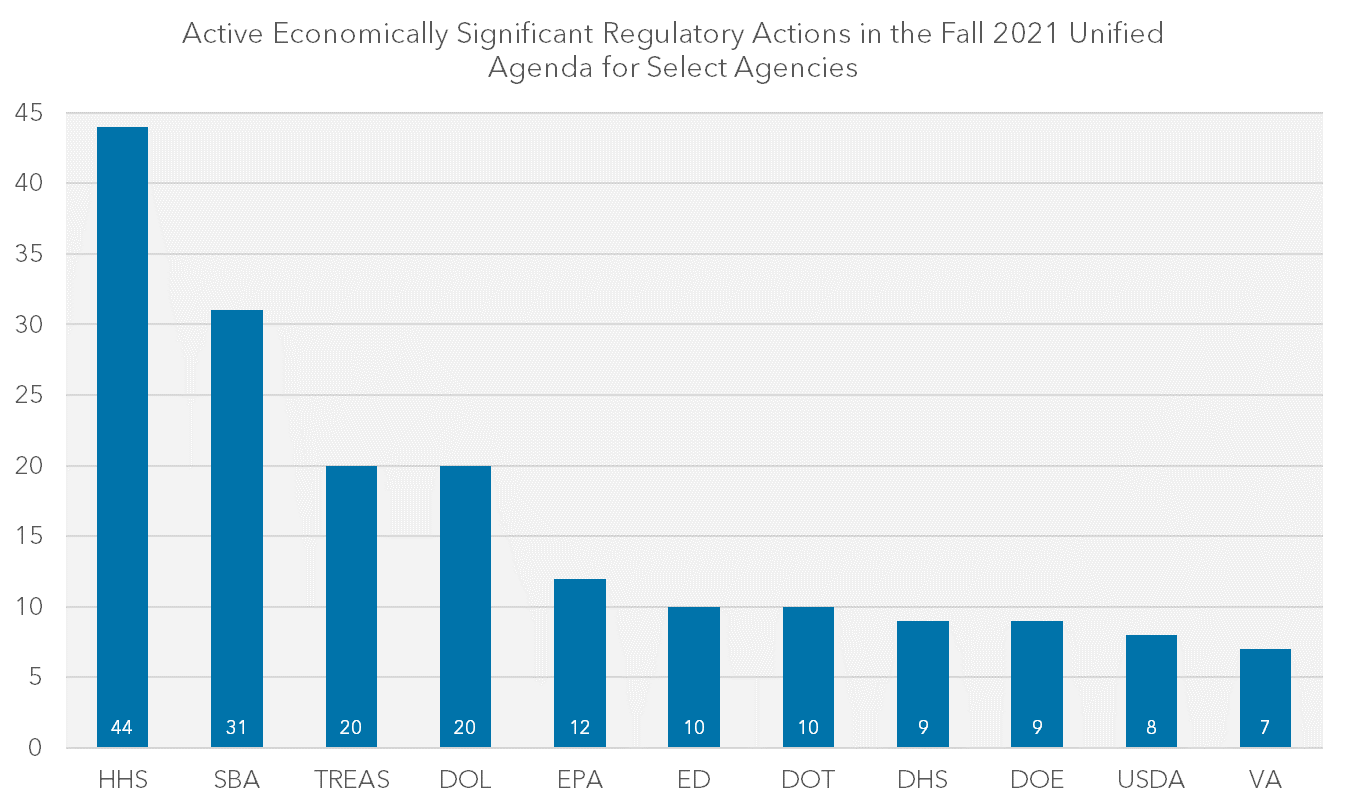Download this Commentary (PDF)
View Analysis of Previous Agenda
In brief...
On Friday, the Office of Information and Regulatory Affairs released its annual Regulatory Plan and semiannual Unified Agenda of Regulatory and Deregulatory Actions. Most agencies echo the Biden administration’s desire to focus on equity concerns in rulemaking in their statements of regulatory priorities. Aside from routine rulemakings, most of the large rules published for the first time in the Fall 2021 Unified Agenda are regulatory actions related to the COVID-19 pandemic or environmental policy.
Introduction
Last Friday, the Office of Information and Regulatory Affairs (OIRA) released its annual Regulatory Plan and semiannual Unified Agenda of Regulatory and Deregulatory Actions. In the Regulatory Plan, agencies detail their regulatory policy priorities and identify substantive rulemakings they expect to act on within the next 12 months. The Unified Agenda contains summaries of all regulatory actions in development at federal regulatory agencies. Altogether, the Fall 2021 Unified Agenda suggests that the COVID-19 pandemic remains a priority for regulatory agencies in addition to a shift away from the previous administration’s environmental policies.
Regulatory Priorities for the Next Year
According to the Introduction to the Fall 2021 Regulatory Plan, “equity, prosperity and public health cut across everything” in the administration’s planned regulatory actions. The Plan lists several of the administration’s highest priorities including regulations to address COVID-19, equity concerns in the housing market, and environmental policies to address climate change. Almost every agency statement of regulatory priorities contained within the Regulatory Plan specifically mentions President Biden’s Executive Order 13985—echoing its directive to address equity concerns via regulatory policy. OIRA notes that the upcoming Spring 2022 Unified Agenda will contain agency plans to implement the Infrastructure Investment and Jobs Act (IIJA)—signed into law by President Biden on November 15, 2021. The Spring 2022 Unified Agenda could presumably also contain actions implementing the Build Back Better Act if it passes the Senate. Sharon Block, Associate Administrator at OIRA, signed this year’s plan since the Biden administration has yet to appoint an OIRA administrator.
What's in the Fall 2021 Agenda?
The Fall 2021 Unified Agenda contains a total of 3,777 agency actions—295 of which are economically significant. These actions are divided by stage of development including: active (the next agency action is expected within 12 months), long-term (beyond 12 months), and completed actions (rules finalized or withdrawn since OIRA released the previous Unified Agenda). Of the 2,678 rules listed as active, 495 (just over 18%) were published for the first time in the Fall 2021 Unified Agenda while 205 are economically significant actions that reflect many of the Biden administration’s top regulatory priorities.
Table 1: Contents of the Fall 2021 Agenda
| Stage | Agency Actions | Economically Significant Actions | First Time Published |
|---|---|---|---|
| Active | 2,678 | 205 | 495 |
| Long-Term | 624 | 50 | 55 |
| Completed | 475 | 40 | 43 |
| Total | 3,777 | 295 | 593 |
Compared to the Spring 2021 Agenda, the total number of actions decreased slightly from 3,961 to 3,777. The number of active rulemakings in this Agenda increased (2,678 compared to 2,551 in the Spring 2021 Unified Agenda). Of those, the number of active economically significant actions is higher than the Biden administration’s Spring 2021 Agenda (205 vs 190), but only 37 of these were published for the first time in this Agenda (compared to 68 in the Spring 2021 Agenda).
The 205 active economically significant rules listed in the 2021 Fall Unified Agenda represent a substantially larger volume of planned regulatory output than agencies anticipated under either Presidents Obama or Trump in their first Fall Agendas. For instance, the 2009 Fall Unified Agenda contained 123 active economically significant actions while the 2017 Fall Unified Agenda listed 71. The Fall 2021 Unified Agenda’s sizeable projection for active economically significant rules is consistent with the Biden administration’s larger regulatory output to date vs. prior administrations. As of the end of November 2021, the Biden administration issued 61 economically significant regulations—outpacing the Obama administration’s previous record of 40 economically significant regulations by the end of November 2009.
Table 2: Economically Significant Rules Published by Executive Branch Agencies under Different Administrations During Their First Ten Months in Office (by November 30th)
| Administration | Clinton | W. Bush | Obama | Trump | Biden |
|---|---|---|---|---|---|
| Economically Significant Rules Published |
35 | 31 | 40 | 17 | 61 |
Economically Significant Actions Highlight Continued Prioritization of the COVID-19 Pandemic and Environmental Policy
Economically significant actions provide a particularly useful measure of an administration’s regulatory output, and the Fall 2021 Unified Agenda contains 205 active entries.
The agencies with the highest number of economically significant actions planned include the Department of Health and Human Services (HHS) (44), the Small Business Administration (SBA) (31), the Department of the Treasury (20), the Department of Labor (DOL) (8), the Environmental Protection Agency (EPA) (12), the Department of Education (ED) (10), the Department of Transportation (DOT) (10), the Department of Homeland Security (DHS) (9), the Department of Energy (9), the Department of Agriculture (USDA) (8), and the Department of Veterans Affairs (VA) (7).
Much of this output is still the result of agency actions to address the COVID-19 pandemic. For instance, all of SBA’s 31 actions implement the Coronavirus Aid, Relief, and Economic Security (CARES) Act as do several of the actions listed by the Treasury Department. One rule at USDA expands its Pandemic Cover Crop Program. HHS lists actions establishing COVID-19 vaccination requirements for providers and suppliers participating in its Medicare and Medicaid programs along with vaccination or regular testing requirements for all staff participating in Head Start Programs. The most sweeping vaccination/testing requirement is the emergency temporary standard issued by DOL’s Occupational Safety and Health Administration. This mandate applies to employers of about two-thirds of the U.S. workforce and has already faced several legal challenges.
One of the actions at HHS is a rule by the Substance Abuse and Mental Health Services Administration (SAMHSA) that will propose making permanent some of the regulatory flexibilities for opioid treatment programs that the agency has provided throughout the COVID-19 public health emergency. The agency made it easier for patients to access take-home supplies of medications to treat opioid use disorder, and research—including a report by my colleagues Bridget Dooling and Laura Stanley—highlights the benefits of making these changes permanent. The agency states that research and stakeholder feedback it received “details that the take home flexibilities have been well received by treatment programs and patients… [with] few reports of diversion or overdose.” SAMHSA expects the change will affect approximately 1,800 treatment programs.
Outside of rules related to the pandemic, the Fall 2021 Unified Agenda contains several actions published for the first time that reflect the current administration’s approach to environmental policy. On his first day in office, President Biden issued an executive order directing agencies to review all environmental actions issued under the Trump administration to ensure their consistency with current administration priorities. The order also instructed agencies to “consider…suspending, revising, or rescinding” specific rules, such as EPA’s residual risk rule for coal- and oil-fired electricity generation and further revisions to the definition of Waters of the United States. Other notable environmental actions include a Department of the Interior rule related to the risks of industry activities on the Outer Continental Shelf and an EPA rule related to the phasedown of hydrofluorocarbons.
Most of the 205 active economically significant actions listed in the Fall 2021 Unified Agenda have appeared in prior Agendas. Much of this reflects ongoing work at agencies to implement Biden administration shifts in regulatory policy in areas such as immigration, healthcare, and higher education. With the exception of routine rulemakings, most of the large rules published for the first time in this Agenda reflect a focus on COVID-19 and environmental policy.
According to Executive Order 12866, an “economically significant” regulatory action is one which has “an annual effect on the economy of $100 million or more or adversely affect in a material way the economy, a sector of the economy, productivity, competition, jobs, the environment, public health or safety, or State, local, or tribal governments or communities.”



